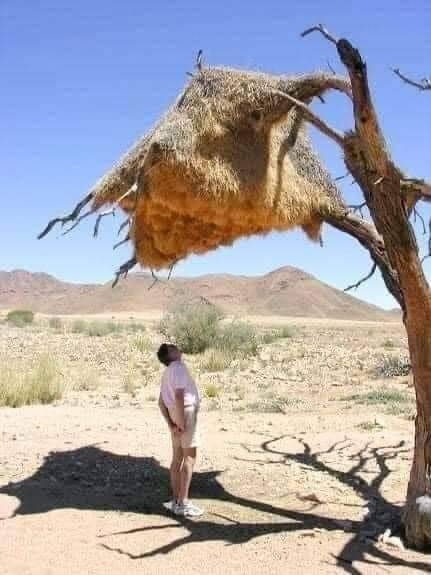A Sociable weaver's giant nest in Namibia, probably the most spectacular structure built by any bird.
The Sociable weaver (Philetairus socius) is a species of bird in the weaver family found across South Africa, Namibia and Botswana. This species construct large compound community nests that resemble huts, complete with a sloping thatched-grass roof that sheds rain. These nests are the world’s largest and most populated tree houses, with some weighing up to a ton or more and measuring up to 20 feet wide and 10 feet tall.
Built around large and sturdy structures like acacia trees or sometimes even telephone poles, the nests provide shelter from direct sunshine, rain, drought, and cold. They are large enough to house over a hundred pairs of birds, consisting of several generations at a time. Each breeding pairs tends to its own compartment with its private entrance and line the interior with soft downy plant material. These entrances are packed closely together and when seen from below, the communal nest has a honeycomb appearance. These birds are constantly making home improvements, adding new nesting chambers, and some nests have remained occupied for over a century!
???? The visual travel diary of Vie & Edo
The Sociable weaver (Philetairus socius) is a species of bird in the weaver family found across South Africa, Namibia and Botswana. This species construct large compound community nests that resemble huts, complete with a sloping thatched-grass roof that sheds rain. These nests are the world’s largest and most populated tree houses, with some weighing up to a ton or more and measuring up to 20 feet wide and 10 feet tall.
Built around large and sturdy structures like acacia trees or sometimes even telephone poles, the nests provide shelter from direct sunshine, rain, drought, and cold. They are large enough to house over a hundred pairs of birds, consisting of several generations at a time. Each breeding pairs tends to its own compartment with its private entrance and line the interior with soft downy plant material. These entrances are packed closely together and when seen from below, the communal nest has a honeycomb appearance. These birds are constantly making home improvements, adding new nesting chambers, and some nests have remained occupied for over a century!
???? The visual travel diary of Vie & Edo
A Sociable weaver's giant nest in Namibia, probably the most spectacular structure built by any bird.
The Sociable weaver (Philetairus socius) is a species of bird in the weaver family found across South Africa, Namibia and Botswana. This species construct large compound community nests that resemble huts, complete with a sloping thatched-grass roof that sheds rain. These nests are the world’s largest and most populated tree houses, with some weighing up to a ton or more and measuring up to 20 feet wide and 10 feet tall.
Built around large and sturdy structures like acacia trees or sometimes even telephone poles, the nests provide shelter from direct sunshine, rain, drought, and cold. They are large enough to house over a hundred pairs of birds, consisting of several generations at a time. Each breeding pairs tends to its own compartment with its private entrance and line the interior with soft downy plant material. These entrances are packed closely together and when seen from below, the communal nest has a honeycomb appearance. These birds are constantly making home improvements, adding new nesting chambers, and some nests have remained occupied for over a century!
???? The visual travel diary of Vie & Edo



